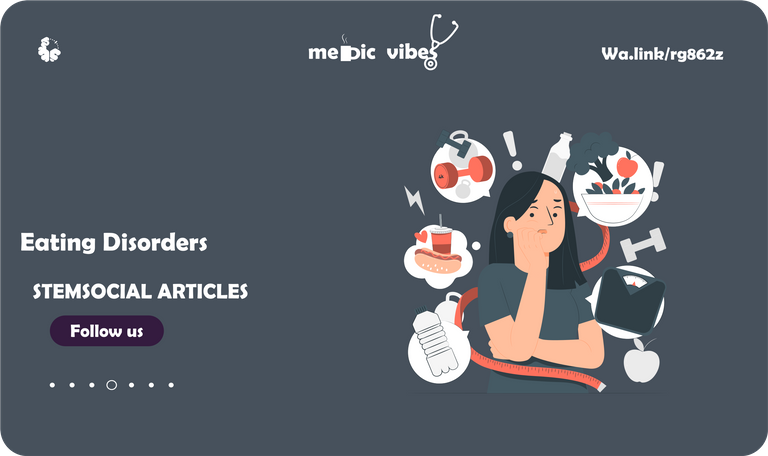Eating Disorders in Nigeria (Results)
Depression vector created by pch.vector - www.freepik.com
In the last post, we saw how:
- Those who have eating disorders tend to be affected by psychiatric conditions.
- 1054 samples were taken and analysed in this study.
- Cognitive behavioural therap and Dynamic psychotherapy are good ajuctive therapy for Eating disorders.
Depression vector created by pch.vector - www.freepik.com
Welcome to Medic Vibes, where we discuss mental health disorders and make sense of them. Dr Ebingo Kigigha is a medical doctor (aspiring psychiatrist) and creative person (illustration and music). This has been our routine for four consecutive months. This month will be dedicated to Eating Disorders. In the first month, we discussed Depression, and in the subsequent month, anxiety. We just finished with Schizophrenia.
In this post, we are looking at research work done in Nigeria on Eating Disorders. To learn more just keep scrolling down. You can also skip to the key point of the post if you which or go to the conclusion to get the summary.

Those who have AN usually end up having a support system that helps them achieve thinness. There is usually evidence of the fact that they have issues with their parents. Those who have this disorder usually have family discord and they are not nurtured in the best environments especially those who have binge eating or purging variety.
Adolescents try to get attention from parents who have marital problems.
Some factors can predict a patient's vulnerability to ED. These are known as vocational and avocational interests. Girls who attend ballet school are 7 times more likely to suffer from eating disorders. For boys, 17% of those on wrestling teams will suffer from ED which improves after the wrestling season spontaneously.
These vocations usually attract people who are perfectionists and create the kind of environment where eating disorders can prevail
In the gay community, it has also been found that men are more likely to be affected by ED because it is common to find gay men who are thin and muscular in this community.
This appears to be the exact opposite in the lesbian community where women have higher weight when compared to heterosexual women.
In adolescence, it is related to sexual function and it appears to be a result of a need to increase sexual function.
The normal obsessions adolescents have at that age are switched for the thought of eating and weight. They do not think for themselves and feel their parents are taking charge of their bodies and they start as an effort to take control or to seek approval from a parent.
It is very hard for a person with AN to become autonomous with their thoughts as this is seen in most cases.

Eating Disorders in Nigeria (Results)

People illustrations by Storyset
1054 students met the inclusion criteria for the study and their data were analysed. 546 subjects were from the University of Lagos and 508 were from the Yaba College of Technology. While analysing the data there was a common problem that was noticed (and has been noticed around the world) when filling in data subject makes some errors. One that was particularly interesting was the issue of age where some filled “adults” into the field.
For this reason, the study was able to analyse some variables and not able to do that for others.
In this study, most of the subjects were males making up 55.6% of the total and 44.8% were females. 49.5$ of the total population were between the age 15 to 20 years The remaining 48.8% were between 21 to 30 years. The average age of participants was 21.38 years (±3.66).
The population was made up of mostly unmarried people making up 97% and 2.7% were unmarried the represented population was 1046.
81.6% were Christians and the remaining were Muslims.
76% of the patients received 1 between ₦10,000 to ₦20,000 from their parents/guardians every month. 11.8% of the subjects received ₦25,000 to ₦30,000 and 10.7% received ₦35,000 and ₦50,000
US$1 at the time was equivalent to ₦150.
84% of the patients in this study were from monogamous families and 16% were from polygamous families. Only 4.7% of the fathers of the subjects were unemployed and most of them were responsible for the financial support for the subjects.
The subjects weighed from 40 to 120 kg and the average weight was 63.29 in a population of 1036.
The height range was between 1.36 to 2.01m and the average height was 1.69m
Body mass index ranged from 15.4 to 68.5 and 72.5% were within the normal BMI range while 13.6 were overweight, 11.1% were underweight and 2.8% were obese.
84.7% of the subjects had a score of less than 20 based on the EAT-26 assessment. While the remaining 15.3% is positive for an eating disorder based on the EAT-26 test. Most of them who were positive were from the college of technology.
The age group with the most positives for an eating disorder was 21 to 30. This was followed up by the age group 15 to 20.
21.9% of females in the study had an eating disorder while 11.6% of males had an eating disorder.
There was no relationship between eating disorders and a sociodemographic of the study population.

Treatment
It is important to check the rest of the family for those who have AN who live with their family so that the proper form of therapy can be instituted. Some cases may not be suitable for family therapy. In these cases, the family problems need to be sorted out with the individual.
In some cases, the patient may require therapy with close family. A study done in the UK showed that some patients younger than 18 had this form of therapy work but the study had no control population.
Most studies on family therapy have not been done with controls but in AN many clinicians are more focused on individual therapy and will provide family therapy if they see it as necessary.
There are no known drugs that can be used effectively for AN. Some studies have shown that cyproheptadine, which works as an antihistamine and serotonergic antagonist works for some patients. The problem is that it only works for some patients.
The antidepressant Amitriptyline has also been shown to have some therapeutic effects. Clomipramine, pimozide and chlorpromazine have been shown to have some effect on therapy.
In some cases, fluoxetine is tried and it shows good results on weight gain. The serotonergic medication also has some positive effects.
For those who have AN and depression, the depression must be treated while treating the patient for AN. The tricyclic antidepressant may have a reduced effect on low weight. Those who have the major depressive disorder may be susceptible to low blood pressure and abnormal heart rhythms and dehydration.
Questions
- What did you learn about Eating Diorders?
Conclusion
- There are social and physiologic factors that can give rise to AN
- Using EAT-26 the there were 15% of people who had eating disorders in the study.
- Family therapy and pharmacology is not particularly helpful in AN

References
- Kaplan-Sadocks-Comprehensive-Textbook-Psychiatry
- Page demarcations made with Inkscape.org
- Healthline
- WebMD


Thanks for your contribution to the STEMsocial community. Feel free to join us on discord to get to know the rest of us!
Please consider delegating to the @stemsocial account (85% of the curation rewards are returned).
You may also include @stemsocial as a beneficiary of the rewards of this post to get a stronger support.